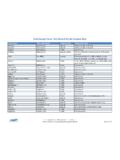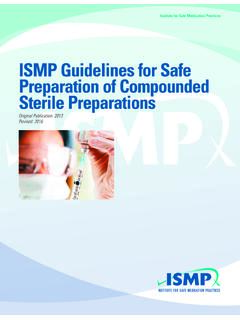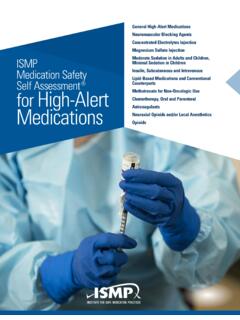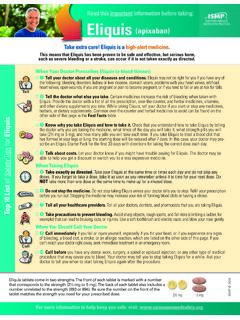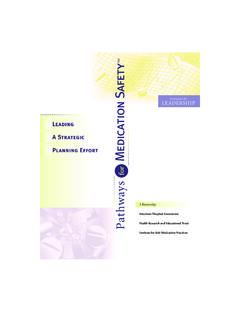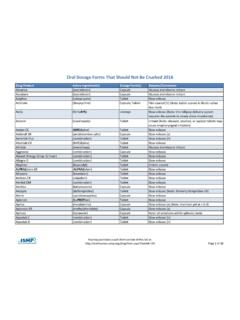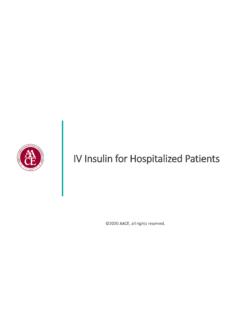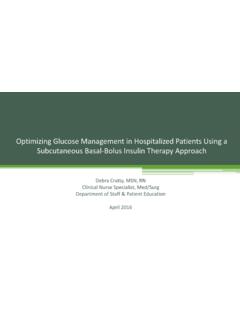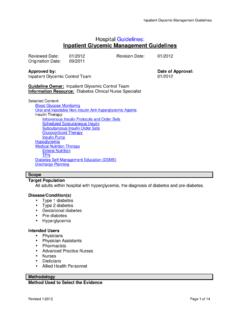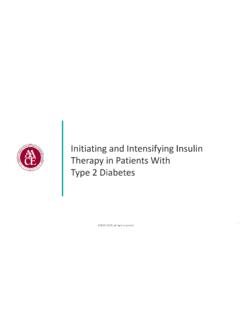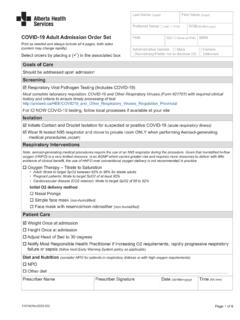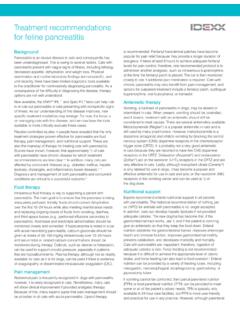Transcription of 2017 ISMP Guidelines for Optimizing Safe Subcutaneous ...
1 2017 ISMP Guidelines for Optimizing Safe Subcutaneous Insulin Use in AdultsTable of ContentsIntroduction 3 Risk Associated with Subcutaneous Insulin Use in Adults 5 Risk Associated with Prescribing Subcutaneous Insulin 6 Risk Associated with Dispensing Subcutaneous Insulin 6 Risk Associated with the Preparation and Administration of Subcutaneous Insulin 7 Risk Associated with the Use of Insulin Pens and Vials 9 Risk Associated with Monitoring patients on Subcutaneous Insulin 11 Risk Associated with Educating patients on Subcutaneous Insulin 11 Developing Consensus Guidelines for Safe Subcutaneous Insulin Use 12 Safe Practice Guidelines for Subcutaneous Insulin Use in Adults 131.
2 Prescribing of Subcutaneous Insulin 132. Pharmacy Management and Distribution of Subcutaneous Insulin 163. Administration and Monitoring of Subcutaneous Insulin 184. Safe Transitions of Care for patients Receiving Subcutaneous Insulin 20 Future Inquiry 22 Conclusion 22 References 23 Definitions
3 28 Summit Participants 29 Appendix A Safe Practice Guidelines for Subcutaneous Insulin Use in Adults 31 Disclosure 34 About ISMP 34 Cover photo taken by ISMP fellow Ghadeer Banasser. 2017 ISMP Guidelines for Optimizing Safe Subcutaneous Insulin Use in mellitus is an increasingly common diagnosis encountered and managed in both the inpatient and outpatient settings. One of the primary goals in diabetes treatment is to reduce episodes of hyperglycemia while minimizing the risk of hypoglycemic episodes.
4 While Subcutaneous insulin therapy is the cornerstone of hyperglycemic treatment, insulin is a high-alert medication that can be associated with significant patient harm when used in as a High-Alert MedicationMedications that are associated with the highest risk of injury when used in error are known as high-alert medications. Insulin has long been identified as belonging to this group of According to a 2014 survey of pharmacists and nurses conducted by the Institute for Safe Medication Practices (ISMP), intravenous (IV)
5 Insulin ranked first, and Subcutaneous insulin ranked ninth among nearly 40 drugs and drug classes identified as high-alert medications that concerned Yet, of all the high-alert medications, Subcutaneous insulin came in last place when pharmacists and nurses were asked to rank how confident they were regarding the effectiveness of hospital-wide precautions to prevent serious errors. The survey findings suggest a consensus among pharmacists and nurses that hospitalized patients are vulnerable to errors with Subcutaneous insulin, and that more must be done to prevent patient harm with this high-alert medication.
6 Incidence of Insulin Errors For many years, insulin has been shown to be associated with more medication errors than any other type or class of drugs. As early as 1998, insulin was associated with 11% of all harmful medication errors in More recent studies add evidence to the high frequency of insulin involvement in harmful medication errors. In 2004, a state reporting program established that 25% of all reported medication errors involved high-alert medications, and 16% involved insulin Data published in 2008 showed that insulin was the leading drug involved in harmful medication errors.
7 Representing 16% of all medication error events with reported A 2010 study found that the most common medical errors in critical care patients were insulin administration Types and Causes of Insulin Errors A variety of error types have been associated with insulin therapy, including administration of the wrong insulin product, improper dosing (under-dosing and overdosing), dose omissions, incorrect use of insulin delivery devices, wrong route (intramuscular versus Subcutaneous ), and improper patient monitoring. Many errors result in serious hypoglycemia or hyperglycemia.
8 Hypoglycemia is often caused by a failure to adjust insulin therapy in response to a reduction in nutritional intake, or an excessive insulin dose stemming from a prescribing or dose measurement Other factors that contribute to serious hypoglycemia include inappropriate timing of insulin doses with food intake, creatinine clearance, body weight, changes in medications that affect blood glucose levels, poor communication during patient transfer to different care teams, and poor coordination of blood glucose testing with insulin administration at meal 2017 ISMP Guidelines for Optimizing Safe Subcutaneous Insulin Use in commonly results from reliance on only sliding scale insulin to control blood glucose, a failure to optimize treatment by increasing the dose of insulin, dosing errors, and dose ,7 Stress from an illness, injury, or surgery; lack of exercise; not following a diabetic diet plan; not injecting insulin properly; using expired insulin.
9 Using certain medications that affect blood glucose levels; or not taking insulin as prescribed due to fear of weight gain are additional factors that contribute to Other system-based barriers to achieving glycemic control include communication failures during TRANSITIONS OF CARE, glucose testing that is not coordinated well with meals and drug therapy, knowledge deficits surrounding treatment, lack of automated clinical alert systems to track and trend glycemic control, and the amount of incremental nursing time needed for complex insulin ,12 Suboptimal prescribing of insulin.
10 Which also leads to hyperglycemia, may be due to a lack of knowledge and expertise on the part of the prescriber or fear of causing 2017 ISMP Guidelines for Optimizing Safe Subcutaneous Insulin Use in Associated with Subcutaneous Insulin Use in AdultsAlthough insulin can be lifesaving, it can also cause life-threatening injuries or death when used inappropriately as both overdoses and under-doses of insulin can cause In an inpatient setting, manifestations of poor glycemic control including severe hypoglycemia and hyperglycemia are deemed hospital-acquired conditions by the Centers for Medicare and Medicaid Services (CMS).
